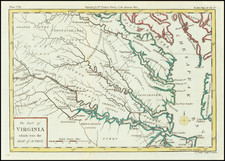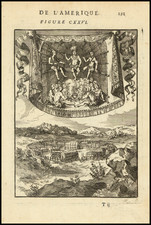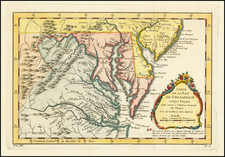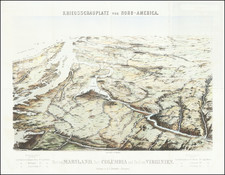Map of the Carolina Coastline, Including the Sir Walter Raleigh's Roanoke Colony
Fine copper plate engraving showing Theodore De Bry's version of John White's painting "The Virginians' Manner of Dancing at Their Religious Festivals."
In the center of the image, a man is depicted from the back, standing, holding a tall bow in his left hand and two arrows in his right. He wears a container of arrows that hangs from his waist. On his left shoulder is a tattoo, or a mark made in paint. Various other marks appear in the spaces to the left and right of the man.
The text translates as follows:
Inhabitants of the whole province [Florida], for the most part, have a mark expressed on their back, by which they can be recognized as to which ruler they are subject, or from which region they originate. For this reason, we have depicted these marks with this figure, adding the names of the places so they can be more easily distinguished: God has granted them this skill, although they are indeed simple; and to tell the truth, I do not remember seeing people who are more honorable or more peaceful.
The marks I have observed are here arranged in a certain series. Marked with the letter A is Wingini, the Lord in Roanoac. Having the letter B, is related to Wingini. Marked with letters C and D are various heroes in SECOTA. To which indeed are added the letters E, F, G, are leading men in Pomeiooc & Aquaskogoc.
In 1585, Governor John White, was part of a voyage from England to the Outer Banks of North Carolina under a plan of Sir Walter Raleigh to settle "Virginia." White was at Roanoke Island for about thirteen months before returning to England for more supplies. During this period he made a series of over seventy watercolor drawings of indigenous people, plants, and animals. The purpose of his drawings was to give those back home an accurate idea of the inhabitants and environment in the New World. The earliest images derived from White's original drawings were made in 1590, when Theodor De Bry made engravings from White's drawings to be printed in Thomas Hariot's account of the journey. Hariot, a mathematician, had also been part of the 1585 voyage.
Theodor de Bry (1528-1598) was a prominent Flemish engraver and publisher best known for his engravings of the New World. Born in Liege, de Bry hailed from the portion of Flanders then controlled by Spain. The de Brys were a family of jewelers and engravers, and young Theodor was trained in those artisanal trades.
As a Lutheran, however, his life and livelihood were threatened when the Spanish Inquisition cracked down on non-Catholics. De Bry was banished and his goods seized in 1570. He fled to Strasbourg, where he studied under the Huguenot engraver Etienne Delaune. He also traveled to Antwerp, London, and Frankfurt, where he settled with his family.
In 1590, de Bry began to publish his Les Grands Voyages, which would eventually stretch to thirty volumes released by de Bry and his two sons. The volumes contained not only important engraved images of the New World, the first many had seen of the geographic novelties, but also several important maps. He also published a collection focused on India Orientalis. Les Grands Voyages was published in German, Latin, French, and English, extending de Bry’s fame and his view of the New World.

![[ The Marks of Sundry of the Chief Men of Virginia ] Aliquot Heroum Virginiae Notae. By Theodor De Bry](https://storage.googleapis.com/raremaps/img/small/98859.jpg)








![[Inhabitants of Virginia] Einwohner von Virginia](https://storage.googleapis.com/raremaps/img/small/94084.jpg)




![[ Aztec Plan of Mexico City ] Facsimile of Page 1 of the Mendoza Collection of Mexican Picture paintings... | Mendoza Col Selden MSS. 3134.](https://storage.googleapis.com/raremaps/img/small/102305.jpg)